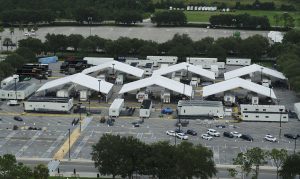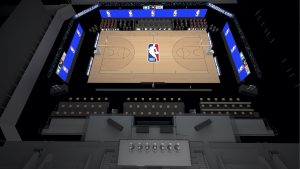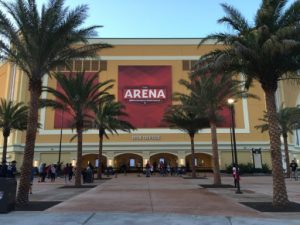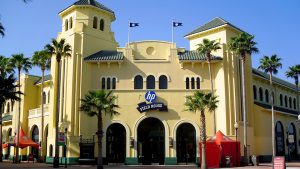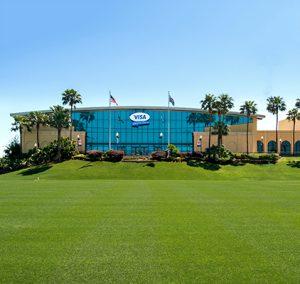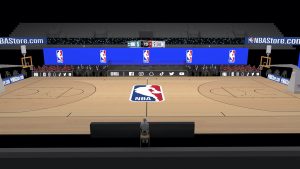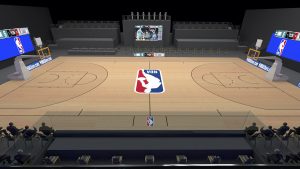NBA Returns: ESPN Brings Plenty of Tech Firepower to Wide World of Sports Productions
Highlights include RailCam, new robos, embedded mics, virtual graphics, and more
Story Highlights
NBA on ESPN is back in business tonight, with its production team resuming live broadcasts from the NBA bubble inside Disney’s Wide World of Sports complex in Orlando. To pull them off safely, the network’s operations team has worked with the NBA and fellow rightsholder Turner Sports to build a massive broadcast compound that echoes an Olympics IBC (international broadcast center) to serve the three arenas hosting the NBA games.
“It’s a tremendous feeling to know that your sport has come back,” says ESPN Senior Operations Manager Patty Mattero. “With everything going on in the world right now, we’re all very happy to just be able to make TV again. There are certainly monumental technical challenges, but we all know the fundamentals of making TV, and we can’t wait.”
In the Compound: NEP EN3 and EN2, Game Creek Victory Power the Production
ESPN, along with the NBA and Turner Sports, spent the better part of two months creating a 94,920-sq.-ft. broadcast compound (equal to roughly three football fields) to house the 13 production trucks, 31 trailers, six mobile-unit cover tents, two catering tents, two field-shop tents, and several cooling stations onsite.
ESPN has rolled out three dedicated twin mobile units to produce the games out of the three venues at WWoS: NEP’s EN3 for The Arena (Court 1, the main national-telecast court and site of Conference Finals and NBA Finals), Game Creek Video’s Victory for HP Field House (Court 2 for the regular season to Second Round), and NEP’s EN2 for Visa Athletic Center (Court 3, primarily for games broadcast exclusively by regional sports networks).
CAT Entertainment Services has rolled out 20 generators to power the compound: 12 500-kVA units, two 300-kVA units, two 400-kVA tow plants, and four 175-kVA tow plants. With the 90+ temperatures in Orlando, the compound is also equipped with 32 20+-ton HVAC units (two of them 60-ton units) with redundancy for mobile-unit support.
ESPN, Turner, and the league have also built a comprehensive NBA fiber ring at WWoS, laying more than 436 miles of fiber throughout the facility. On the transmission side, the NBA compound is sending out 65 transmission paths with 14 paths returning, plus 92 (and counting) NBA HSAN feeds and an additional 190 Gbps in bandwidth for file-sharing and redundancy needs.
“Our operations team has done an unbelievable job,” ESPN VP, Production, Michael Shiffman said this week. “It really represents ingenuity, innovation, technology, and — above all else — a ‘can-do’ mentality, which I believe is one of the hallmarks of our company. This is the latest example and has allowed us to hit the ground running with these scrimmages and get us ready to go for Friday night.”
GREMI and REMI: At-Home Model Is Out in Full Force
ESPN is deploying its GREMI model for the majority of its games (including nearly all games at The Arena and HP Field House), as it has for its NBA coverage for the past two years. Under the GREMI model, EVS replay and Vizrt graphics systems are located onsite in the trucks, but three or four replay operators and all graphics and scorebug operators are at the ESPN facility in Bristol, CT.
ESPN and Turner are also creating a neutral world feed that RSNs around the country will use to produce in-market telecasts from their home facilities. In addition to the world-feed line cut, ESPN is delivering a dedicated iso camera feed to each RSN (which has full comms to the camera operator) and access to several other camera feeds to integrate into its telecast.
Although EN2 is on hand to serve some of the RSN-exclusive games at the Visa Athletic Center, the majority of them will be REMI (remote-integration) productions in which feeds are sent to control rooms in Bristol. According to Mattero, this is the first time ESPN has produced NBA games as full REMI productions from control rooms in Bristol.
“Because all of our sports are coming back, our control rooms are insanely busy trying to juggle all the events and all content coming back to Bristol,” says Mattero. “What Bristol can support determines how we’re going to cover the games. The majority are REMI, but there are also quite a few of them that will be more of a GREMI setup out of EN2.”
Safety Protocols in the Compound: Keeping the Crew Healthy
To ensure social distancing, ESPN has doubled the usual distance between trailers/trucks. To limit the number of people in each truck, the network has also reorganized several crew positions, outboarding multiple replay operators, robotic-camera shaders, and audio personnel to other locations in the compound.
“In this environment, we are putting safety first and taking extra steps to ensure health and safety of everyone,” says Mattero. “We have only six people in the majority of our A units; that’s about half of what we would normally have. There is plexiglass separating people, and we’ve mapped it out so everyone is spaced far enough apart based on ESPN and Disney protocols. And, of course, everyone is wearing masks. We’re all trying to get used to a whole new way of doing business, but we know how important it is to do it the right way.”
The crew has been divided into functional groups, with the majority of the production and operations staff in the “yellow zone,” commuting solely between their hotel on Disney property and WWoS. Individuals are also restricted to specific trucks and trailers to minimize cross-contamination among the crew. Crew members are required to wear face masks and maintain social distancing at all times. All onsite staff are tested for COVID-19 twice a week and have daily temperature tests on arriving at the facility.
Camera Coverage: RailCam Takes Center Stage, Manned Positions Shift to Robos
More than 250 cameras have been deployed across the WWoS complex, including more than 60 robos and PTZ cameras. Each venue is equipped with 30+ cameras for game coverage, with The Arena and HP having roughly the same camera complement and Visa Athletic Center a slightly smaller one. ESPN and Turner will share the same camera positions in all venues.
“We’re really excited about some of our new camera angles, which was a collaboration between us, Turner, and the league,” says Shiffman. “Working with the league [offers] unique opportunities for the audio soundtrack from the games and other broadcast enhancements that come with the opportunity of doing games in this unique environment.”
Chief among the new production elements is the RailCam system at both The Arena and HP Fieldhouse, which will glide along the court at floor level to create a valuable new shot for ESPN and TNT coverage. The RailCam operator is located inside the arena with a full view of the court. Shiffman says he expects RailCam to play a predominant role in ESPN’s coverage but will not be used as a primary game camera.
“The RailCam is a terrific new opportunity, but it comes to some challenges,” he points out. “The referee runs in front of it at times, or, if the ball’s on the far side, it can be challenging for a fan at home to see. [For example], if [Rockets point guard] Russell Westbrook, who oftentimes darts to the hoop, has the ball, you probably don’t want to go to RailCam because of his speed. You may miss his dart to the hoop. Whereas, if someone [who] may be a little more deliberate with the ball and is on the near side in front of that RailCam, you would go to it live.”
Nearly all court-level cameras, normally manned positions, have been converted to robos. Seven cameras (depending on the venue and the game) continue to be manned: one center-court handheld (the only court-level unit), three up cameras (game, tight, and second tight), left and right slash, and reverse shots.
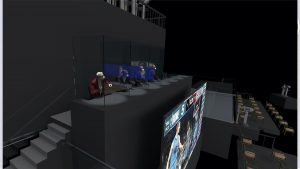
ESPN, TNT, and NBA TV announcers will be higher up than their typical courtside seat and in a plexiglass-surrounded booth.
“Our court coverage would traditionally have quite a few more than seven manned cameras heading into the playoffs,” says Mattero, “but a significant amount of robotics have been uniquely placed to take the place of manned cameras. The biggest difference in the overall look and how the game is produced will be not having any handhelds under the baskets and to follow the players back to the bench during timeouts. All of that will be uniquely covered with below-the-rim robos and foul-line extended robotics.”
In addition, a significant number of robotic cameras have been positioned atop, behind, and below the backboards, as well as in locker rooms and hallways, and at practice facilities to capture behind-the-scenes action.
“The practice court and the tunnel [robotic] cameras will give unique shots and really document holistically what’s going on at [WWoS] at any given moment,” says Shiffman.
ESPN, Turner, and the league will take advantage of the lack of fans in the arena by positioning cameras in ways they have never been placed before as the season continue. Drones are also being used outside the arenas to capture scenic shots from the WWoS campus.
Broadcast Audio: Despite Fanless Stands, ESPN Embraces New In-Arena Sound
A total of 357 microphones have been deployed (119 per court) across the three venues, including 34 microphones embedded in each court to capture sneaker squeaks, player interaction, and other sounds of the game rarely heard with thousands of fans in the arena.
“It’s a cool new opportunity — whether it’s the chatter of the game or when a guy dunks or blocks a shot [and you hear a] yell of excitement. [With] the combination of both the new cameras and that audio, you do feel closer to the game and feel like it’s a more intimate experience or that you’re in the arena.”
Mics will also be deployed around the benches, court, and backboards, and ESPN and Turner plan to mike coaches, players, and referees more often than usual to capture in-game audio. Viewers will be able to hear refs’ explanations of replay challenges because the officials will be communicating directly with the scorer’s table (which is behind plexiglass) via an intercom.
“With coaches mics, we are aggressive about access,” says Shiffman, “but we also respect that they’re doing a job and relaying strategy to their teams. But, even in normal circumstances, if there’s audio that we feel enhances the broadcast and is beneficial for the fan to hear and see without being an invasion of privacy for the coach or the team, then we’ll play that back.”
The league is handling all in-venue audio and simulated crowd noise with team-specific DJs and PA announcers onsite to re-create the sounds and experiences typically expected at the home team’s arena. Each game will feature home-team audio branding, crowd audio loops based on what the home arena would sound like, and team-specific music. ESPN, Turner, and NBA TV will incorporate the audio into their telecasts as part of the in-arena nat sound (crowd noise will not be directly integrated into the broadcast-audio mix).
“I think one of the things the league has done really well here is making [the in-arena simulated crowd noise] natural to the home team,” Shiffman explains. “If it’s a Lakers game, it will sound like Staples [Center] – whether it be the music being played, the PA, or what the fans would sound like in Staples, which may be different from Milwaukee and Boston, etc. It feels authentic in that way, and it sounds like what a Laker home game would sound like.”
As for on-air talent, ESPN, TNT, and NBA TV announcers will be located higher up than their typical courtside seat in a plexiglass-surrounded booth to ensure social distancing. In addition, pregame, in-game, and postgame interviews will be conducted at 6+ ft. with reporter and player having their own microphones. Shiffman says that ESPN’s announcers seamlessly transitioned into calling games without crowds during scrimmage rehearsals and that on-air talent will even embrace the new sound of the broadcast at times with silence.
“We have looked for opportunities and will continue to do so when it’s appropriate to lay out a little bit and just take in the sounds of the game and the squeaks and the chatter,” he says.
In the Venue: Virtual Graphics, But Real-Life Fans
With no fans in the stands, the NBA lined three sides of the court with 17-ft. LED videoboards that will integrate live video of 300+ real fans using Microsoft Teams’ Together mode.
“Individual franchises are going to bring in fans who can video-conference into games and react live in the moment,” says Shiffman. “Thus far, in the testing we’ve seen, it has looked pretty cool.”
Virtual graphics/signage will also be used to integrate sponsorship and other content directly on the court, and ESPN, Turner, and the RSNs are able to customize these elements for their respective broadcasts.
“We worked closely with the league on it and internally with our technology group in terms of being able to [integrate virtual graphics] seamlessly,” says Shiffman. “I’m hopeful that there are also some learnings from it and some new and unique opportunities during this restart — be it for some of our ad-sales partners or in a content play — and also going forward into the next season.”
ESPN’s NBA coverage resumes tonight at 6:30 p.m. ET with Celtics-Bucks followed by Rockets-Mavericks at 9 p.m.
Check out all of SVG’s ‘NBA Returns’ Coverage:
ESPN, Turner, NBA Team Up for Sprawling, COVID-Safe Production at Wide World of Sports
ESPN Brings Plenty of Tech Firepower to Wide World of Sports Productions
NBA Returns: MLSE Calls Dome Productions’ Parking Lot, Echo Unit Home for Raptors Coverage
…and stay tuned for more next week!
